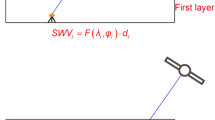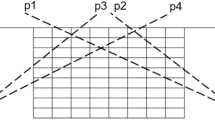Abstract
The GNSS tropospheric tomography technique has been proven to be a powerful tool for three-dimensional water vapor reconstruction. In most previous studies, the signals leaving the side face of the tomography area are ignored as having invalid information, which wastes valuable observations and decreases signal coverage of the research area. To include the contribution of such signals to the final tomographic result, an improved tropospheric tomography approach, which makes the most use of GNSS observations by combining the data derived from the empirical Global Pressure and Temperature 2 wet model, is proposed. Compared to the conventional method, the proposed method can adaptively use the signals penetrating from the model’s side face to the tomographic model, which increases the number of voxels crossed by rays and improves the stability of the tomography model. Numerical results in Hong Kong over the period of day of year 124–150, 2013 show that the internal accuracy of the tomographic model based on the proposed method increases by 9.8% when compared to the conventional method. The RMS errors of the integrated water vapor derived from the proposed method are 4.1 and 4.6 mm, respectively, while the values derived from the conventional method are 5.0 and 5.4 mm, respectively, when compared to the radiosonde and European Centre for Medium-Range Weather Forecasts (ECMWF) products. In addition, compared to the conventional method, the accuracy of the water vapor density profile derived from the tomographic result of the proposed method has been enhanced by 25% and 12.5% when the radiosonde and ECMWF data are considered as the reference, respectively. Such results indicate a good performance of the proposed method for GNSS troposphere tomography.













Similar content being viewed by others
References
Alshawaf F, Fuhrmann T, Knöpfler A, Luo X, Mayer M, Hinz S, Heck B (2015) Accurate estimation of atmospheric water vapor using GNSS observations and surface meteorological data. IEEE Trans Geosci Remote Sens 53(7):3764–3771
Benevides P, Catalão J, Miranda PM (2014) Experimental GNSS tomography study in Lisbon (Portugal). Física de la Tierra 26:65–79
Benevides P, Nico G, Catalao J, Miranda P (2015) Merging SAR interferometry and GPS tomography for high-resolution mapping of 3D tropospheric water vapor. In 2015 IEEE international geoscience and remote sensing symposium (IGARSS) 3607–3610.
Benevides P, Nico G, Catalão J, Miranda PMA (2016) Bridging InSAR and GPS tomography: a new differential geometrical constraint. IEEE Trans Geosci Remote Sens 54(2):697–702
Bevis M, Businger S, Herring T, Rocken C, Anthes R, Ware R (1992) GPS meteorology-remote sensing of atmospheric water vapor using the global positioning system. J Geophys Res 97(D14):15787–15801
Bi Y, Mao J, Li C (2006) Preliminary results of 4-D water vapor tomography in the troposphere using GPS. Adv Atmos Sci 23(4):551–560
Böhm J, Möller G, Schindelegger M, Pain G, Weber R (2015) Development of an improved empirical model for slant delays in the troposphere (GPT2w). GPS Solut 19(3):433–441
Böhm J, Niell A, Tregoning P, Schuh H (2006) Global mapping function (GMF): a new empirical mapping function based on numerical weather model data. Geophys Res Lett 33(7):1–4
Champollion C, Masson F, Bouin MN, Walpersdorf A, Doerflinger E, Bock O, Van Baelen J (2005) GPS water vapor tomography: preliminary results from the ESCOMPTE field experiment. Atmos Res 74(1):253–274
Chen B, Liu Z (2014) Voxel-optimized regional water vapor tomography and comparison with radiosonde and numerical weather model. J Geodesy 88(7):691–703
Elósegui P, Ruis A, Davis JL, Ruffini G, Keihm SJ, Bürki B, Kruse LP (1998) An experiment for estimation of the spatial and temporal variations of water vapor using GPS data. Phys Chem Earth 23(1):125–130
Flores A, Ruffini G, Rius A (2000) 4D tropospheric tomography using GPS slant wet delays. Ann Geophys 18(2):223–234
Gendt G, Dick G, Reigber C, Tomassini M, Liu Y, Ramatschi M (2004) Near real time GPS water vapor monitoring for numerical weather prediction in Germany. J Meteorol Soc Jpn 82(1B):361–370
Guo J, Yang F, Shi J, Xu C (2016) An optimal weighting method of global positioning system (GPS) troposphere tomography. IEEE J Sel Top Appl Earth Observations Remote Sens 9(12):2880–5887
Gutman SI, Sahm SR, Benjamin SG, Schwartz BE, Holub KL, Stewart JQ, Smith TL (2004) Rapid retrieval and assimilation of ground based GPS precipitable water observations at the NOAA forecast systems laboratory: impact on weather forecasts. J Meteorol Soc Jpn 82(1B):351–360
Haan SD, Holleman I, Holtslag AA (2009) Real-time water vapor maps from a GPS surface network: Construction, validation, and applications. J Appl Meteorol Climatol 48(7):1302–1316
Herring TA, King RW, McClusky SC (2006) GPS analysis at MIT, GAMIT reference manual, Release 10.3. Massachusetts Institute of Technology.
Heublein M, Zhu XX, Alshawaf F, Mayer M, Bamler R, Hinz S (2015) Compressive sensing for neutrospheric water vapor tomography using GNSS and InSAR observations. In geoscience and remote sensing symposium (IGARSS), 2015 IEEE international IEEE 5268–5271.
Liu YX, Chen YQ, Liu JN (2001) Determination of weighted mean tropospheric temperature using ground meteorological measurements. Geospat Inf Sci 4(1):14–18
Liu Z, Wong MS, Nichol J, Chan PW (2013) A multi-sensor study of water vapor from radiosonde, MODIS and AERONET: a case study of Hong Kong. Int J Climatol 33(1):109–120
Mendes V (1999) Modeling the neutral-atmospheric propagation delay in radiometric space techniques. Ph.D. dissertation, Univ. New Brunswick, Brunswick
Notarpietro R, Cucca M, Gabella M, Venuti G, Perona G (2011) Tomographic reconstruction of wet and total refractivity fields from GNSS receiver networks. Adv Space Res 47(5):898–912
Posada R, García-Ortega E, Sánchez JL, López L (2013) Verification of the MM5 model using radiosonde data from Madrid-Barajas airport. Atmos Res 122:174–182
Rius A, Ruffini G, Cucurull L (1997) Improving the vertical resolution of ionospheric tomography with GPS occultations. Geophys Res Lett 24(18):2291–2294
Rocken C, Hove TV, Johnson J, Solheim F, Ware R, Bevis M, Businger S (1995) GPS/STORM-GPS sensing of atmospheric water vapor for meteorology. J Atmos Ocean Technol 12(3):468–478
Rohm W, Bosy J (2009) Local tomography troposphere model over mountains area. Atmos Res 93(4):777–783
Rohm W, Bosy J (2011) The verification of GNSS tropospheric tomography model in a mountainous area. Adv Space Res 47(10):1721–1730
Saastamoinen J (1972) Atmospheric correction for the troposphere and stratosphere in radio ranging satellites. Artif Satell Geodesy 15:247–251
Skone S, Hoyle V (2005) Troposphere modeling in a regional GPS network. Positioning 1(09):230–239
Smith TL, Benjamin SG, Gutman SI, Sahm S (2007) Short-range forecast impact from assimilation of GPS-IPW observations into the rapid update cycle. Mon Weather Rev 135(8):2914–2930
Troller M, Geiger A, Brockmann E, Bettems JM, Bürki B, Kahle HG (2006) Tomographic determination of the spatial distribution of water vapor using GPS observations. Adv Space Res 37(12):2211–2217
Wang X, Wang X, Dai Z, Ke F, Cao Y, Wang F, Song L (2014) Tropospheric wet refractivity tomography based on the BeiDou satellite system. Adv Atmos Sci 31(2):355–362
Yao YB, Zhao QZ, Zhang B (2016) A method to improve the utilization of GNSS observation for water vapor tomography. Ann Geophys 34(1):143–152
Yao Y, Zhao Q (2016a) Maximally Using GPS Observation for Water Vapor Tomography. IEEE Trans Geosci Remote Sens 54(12):7185–7196
Yao Y, Zhao Q (2016b) A novel, optimized approach of voxel division for water vapor tomography. Meteorol Atmos Phys 129(1):57–70
Ye S, Xia P, Cai C (2016) Optimization of GPS water vapor tomography technique with radiosonde and COSMIC historical data. Ann Geophys 34(9):789–799
Zhao Q, Yao Y, Yao W (2017) A troposphere tomography method considering the weighting of input information. Ann Geophys 35(6):1327–1340
Zhao Q, Yao Y, Yao W, Xia P (2018) An optimal tropospheric tomography approach with the support of an auxiliary area. Ann Geophys 36(4):1037–1046
Acknowledgement
The authors would like to thank IGRA and ECMWF for providing access to the web-based meteorological data, the International GNSS Service (IGS) for providing precise GPS satellite orbit data and IGS observations, the Survey and Mapping Office of Lands Department in Hong Kong for providing the GPS and meteorological observations. This research was supported by the National Natural Science Foundation of China (41904036).
Author information
Authors and Affiliations
Corresponding author
Additional information
Publisher's Note
Springer Nature remains neutral with regard to jurisdictional claims in published maps and institutional affiliations.
Rights and permissions
About this article
Cite this article
Zhao, Q., Yao, W., Yao, Y. et al. An improved GNSS tropospheric tomography method with the GPT2w model. GPS Solut 24, 60 (2020). https://doi.org/10.1007/s10291-020-0974-4
Received:
Accepted:
Published:
DOI: https://doi.org/10.1007/s10291-020-0974-4




